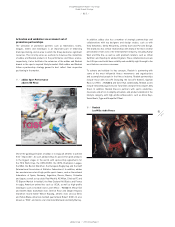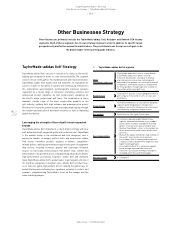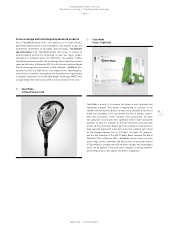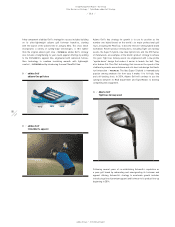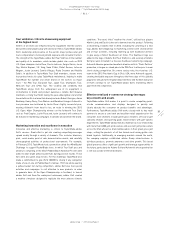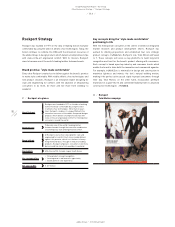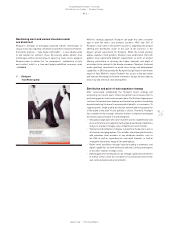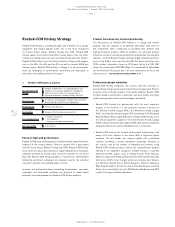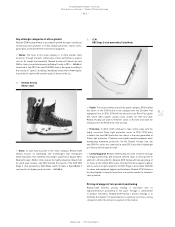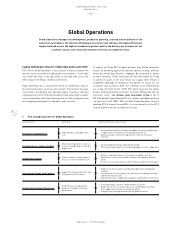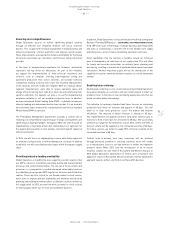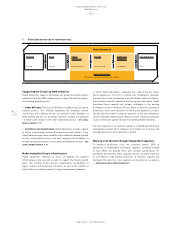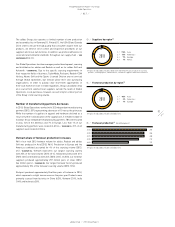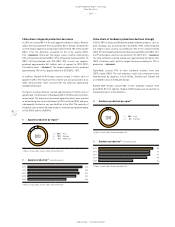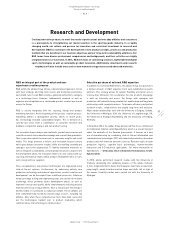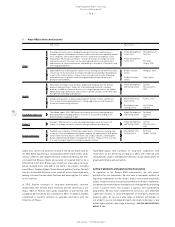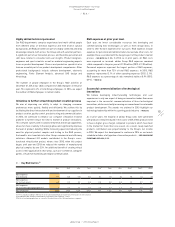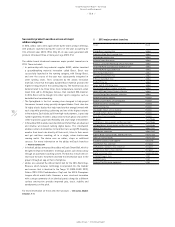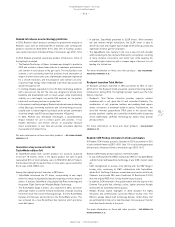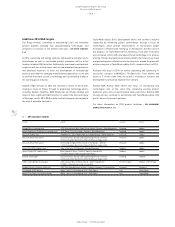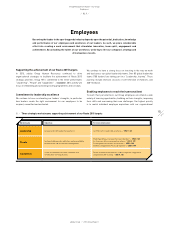Reebok 2013 Annual Report Download - page 99
Download and view the complete annual report
Please find page 99 of the 2013 Reebok annual report below. You can navigate through the pages in the report by either clicking on the pages listed below, or by using the keyword search tool below to find specific information within the annual report.
adidas Group
/
2013 Annual Report
Group Management Report – Our Group
95
2013
Global Operations
/
02.7
/
Ensuring cost competitiveness
Global Operations focuses on further optimising product creation
through an efficient and simplified material and colour selection
process. This, coupled with increased automation in manufacturing, will
enhance productivity, shorten lead times and improve overall quality.
These improvements are expected to enhance profitability for the Group
and ensure we provide our consumers with the best value proposition
possible.
In the area of manufacturing excellence for footwear, automation
represents the key driver for efficiencies. As part of this initiative,
we support the implementation of state-of-the-art machinery and
solutions, such as computer stitching, high-frequency cutting and
automated production lines across factories, and provide technical
competency training to factory floor staff. The resulting improvements
in the factories are both visible and tangible. With less manual labour
required, manufacturers were able to reduce operating space and
energy while increasing their right-first-time rate and optimising their
operator utilisation. For apparel, our goal is to use the manufacturing
excellence initiative to roll out modular production lines. In addition,
we have introduced Global Sewing Data (GSD) – a globally recognised,
industry-leading pre-determined motion time system. It is an accurate
and consistent way to measure the standard production time or Standard
Minute Value (SMV) of a product.
The Profitability Management department assumes a central role in
realising cost competitiveness by driving our strategic costing efforts and
optimising our buying strategies. Throughout 2013, the team focused on
implementing a more data-driven and standardised cost approach for
the apparel division which, in turn, enables consistent benefit capture of
efficiency initiatives.
In 2014, we will focus on implementing a more data-driven approach
for material costing in order to further manage our cost base. In addition
to material, we will consolidate product types within the apparel supply
chain.
Providing industry-leading availability
Global Operations is building five new supporting system solutions that
use SAP as a basis to standardise, automate, bundle and execute market
processes and system functionalities. The roll-out of these systems and
processes is a prerequisite to enable enhanced value-added services
(e.g. labelling, price tags and RFID tags) at our factories and distribution
centres. These are also critical for our flexible make-to-stock service,
which aims to improve product availability and inventory utilisation by
planning and building inventory buffers at different locations further up
the supply chain. In 2013, we went live with our make-to-stock solution
for the European never-out-of-stock and teamwear business.
In addition, Global Operations is a key contributor to the Group’s Integrated
Business Planning (IBP) project
/
SEE INTERNAL GROUP MANAGEMENT SYSTEM,
P. 118. IBP forms part of the Group’s strategic business plan Route 2015
and aims at establishing a coherent end-to-end demand and supply
planning process across finance, marketing, operations and sales.
Other capabilities that the function is building include an increased
level of transparency on lead times in our supply chain. This will allow
for timely and accurate instructions on delivery times, planning and
purchasing, resulting in a reduction of workload and increased customer
satisfaction. Another important aspect will be the introduction of the
capability to transfer inventory between locations in a more automated
manner.
Enabling later ordering
Enabling later ordering is a cross-functional priority in Global Operations
focused on allowing our customers and own-retail network to order our
products closer to the time of sale, facilitating buying decisions that are
based on better market knowledge.
This initiative for reducing standard lead times focuses on shortening
production lead times on footwear and apparel to 60 days. This will
allow us to align sales processes across the brands and improve
efficiencies. The majority of adidas footwear is already on 60 days.
The implementation for apparel started in early 2012, with the goal to
transition a third of all styles for all brands to 60 days. We successfully
achieved our target for the fall/winter season 2014, where over 50% of
forecast volume will be supplied on the shortened lead time of 60 days.
For future seasons, we target to supply 90% of forecast volume on the
shortened lead time of 60 days.
Further order-to-delivery lead time reductions will be achieved
through increased proximity to sourcing countries, which will enable
us to manufacture closer to our key markets to deliver and replenish
products faster. While 2012 saw the introduction of an in-season
response solution for own retail in Russia/CIS and Western Europe, in
2013 Global Operations replenished 5.7 million units of footwear and
apparel in-season in Russia/CIS. We will continue to further develop this
approach towards almost one third of our Russia/CIS business.


